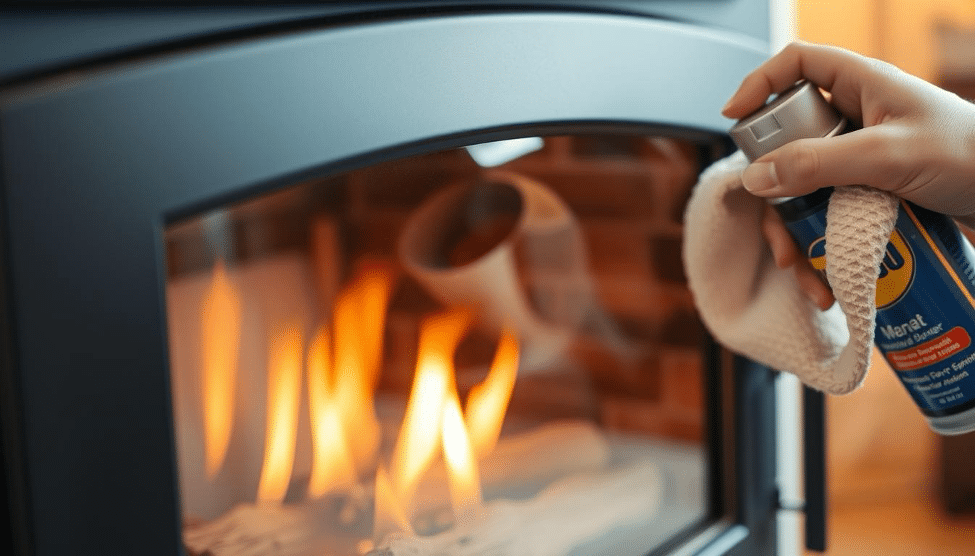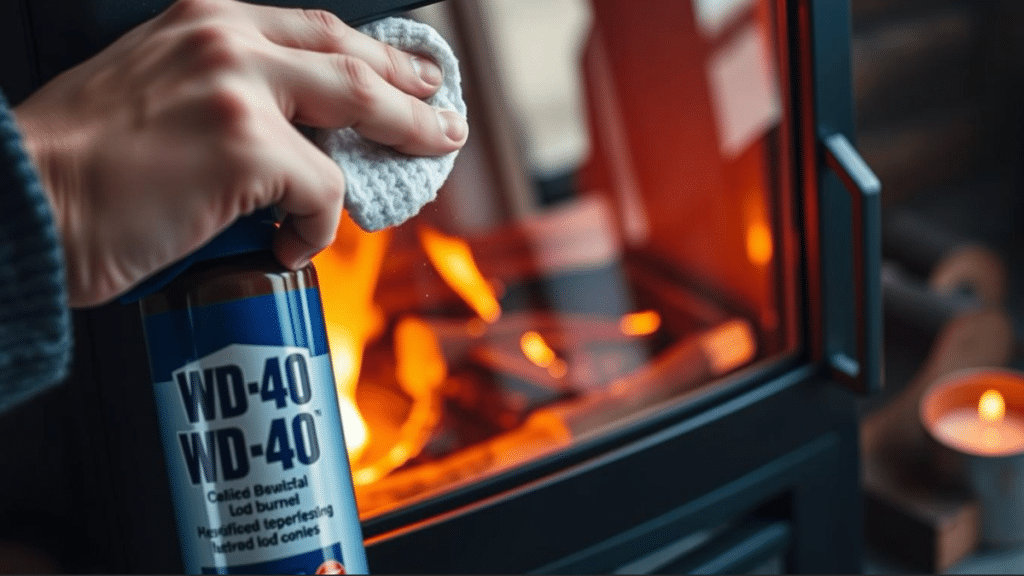Keeping a log burner in good shape is rewarding. It adds warmth and charm to your home. But, it needs care, from cleaning the glass to picking the right wood. This guide will share key tips to keep your log burner working well. It will ensure it heats efficiently and looks great for a long time.
Cleaning the glass is a big challenge for log burner owners. A dirty glass can ruin the look. But, the right cleaning method can make it shine again. We’ll look at using WD-40 and other ways to get a clean, streak-free glass.
The wood you burn also matters a lot. Wet wood can lower heat, increase creosote, and harm your burner. We’ll talk about how to season and store wood right. This way, you’ll always burn the cleanest, most efficient fuel.
This guide is for both seasoned log burner users and newcomers. It will teach you how to get the most from your log burner. You’ll learn about the best wood, safety tips, and how to boost your burner’s efficiency and heat.
Introduction to Log Burners
Log burners are gaining popularity in homes for their efficiency, warmth, and eco-friendliness. They use wood as fuel, creating a cozy atmosphere. They are also cost-effective and good for the environment.
The core of a log burner is its combustion chamber where wood burns. This area is surrounded by metal or cast-iron, spreading heat around. The glass panel lets you see the flames, enhancing the room’s ambiance.

Keeping a log burner clean is key for its performance and life span. The glass panel needs regular cleaning for a clear view and better heat. WD-40 is great for removing tough stains and grime from the glass.
Knowing how a log burner works and the need for upkeep helps it last longer. Cleaning regularly, using WD-40, and choosing the right wood are all important. These steps ensure your log burner heats efficiently for many years.
Importance of Maintaining a Clean Log Burner
Keeping your log burner clean is key for its best performance, safety, and life span. A clean log burner looks great and works better. It lets you enjoy your firewood more efficiently.
Wet wood is a big problem for log burners. It makes lots of smoke and soot, covering the glass and hiding the flames. It also builds up creosote, a flammable substance that’s dangerous if not cleaned.
Using dry, seasoned firewood keeps your log burner running smoothly. This means less cleaning and more warmth for your home. It’s a win-win for comfort and convenience.
Cleaning Log Burner Glass with WD-40
Keeping your log burner glass clean is key for a warm and cozy home. Cleaning log burner glass with WD-40 is an effective method. It cuts through tough soot and grime, making your glass shine.
First, ensure your log burner is cool and unplugged. Spray WD-40 all over the glass and let it sit for a few minutes to break down the dirt. Then, wipe it clean with a dry cloth, continuing until the glass is spotless.
Be cautious when using WD-40, as it can catch fire. Work in a well-ventilated area and avoid any heat sources. Also, make sure to dry the glass thoroughly before lighting the burner again to stay safe.
With this method, you can make your log burner glass look new again, enhancing both its appearance and functionality. Regular cleaning helps keep your log burner operating efficiently and looking great.
Alternative Methods for Cleaning Log Burner Glass
WD-40 is great for cleaning log burner glass, but there are other ways too. Special glass cleaners for fireplaces and wood stoves are popular. They are safe for high heat and remove soot and grime well.
Vinegar is a natural option. Mix equal parts white vinegar and water in a spray bottle. Then, wipe the glass with a soft cloth or paper towel. Vinegar’s acidity breaks down residue. You can also use scrub pads or steel wool, but be careful not to scratch.
Cleaning your log burner glass often is key. So, clean it as soon as you see soot or grime. With the right method and effort, your glass will stay clean and shiny, even after many fires.
Choosing the Right Wood for Your Log Burner
The type of wood you choose for your log burner is very important. It affects how well your heating system works. Knowing the differences between various wood types helps you make a good choice.
Moisture content is a key factor. Wet wood can cause problems like less heat, more smoke, and chimney buildup. It’s best to use dry, seasoned wood. This wood burns cleaner, gives more heat, and keeps your log burner healthy.
The burn rate of wood is also crucial. Different woods burn at different rates. Hardwoods like oak and ash burn slower, making them great for log burners. They provide steady heat for a long time. Softwoods, like pine, burn faster and need more refueling.
Choosing the right wood for your log burner ensures it works well. This means your home stays warm and cozy during cold months. Always avoid using wet wood to keep your log burner in top shape.
Why You Need to Avoid Wet Wood
Choosing the right wood for your log burner is crucial. Wet or unseasoned wood can harm your stove’s performance, leading to problems you’ll want to avoid. This is why you need to avoid wet wood. Wet wood doesn’t burn well, which means less heat for your home. Dry, seasoned wood, on the other hand, burns hotter and more efficiently, providing you with more warmth and comfort.
Wet wood also produces more smoke and emissions, which is bad for your health and the environment. The extra moisture in the wood causes increased smoke and harmful particles. Additionally, using wet wood can lead to creosote buildup in your chimney. This tar-like substance can block airflow and increase fire risks, potentially damaging your stove over time.
Using dry, seasoned wood ensures your log burner works its best, giving you warmth and comfort while avoiding the dangers associated with wet wood.
Seasoning and Storing Firewood
Using a log burner well means your firewood must be seasoned and stored right. Wet wood burns poorly, causing smoke, soot, and damage. So, it’s vital to avoid using wet wood.
Seasoning lowers wood’s moisture. Aim for 20% moisture or less. This takes 6-12 months, depending on the weather and where you store it. Seasoned wood burns cleaner, hotter, and more efficiently.
Storing seasoned wood correctly is also key. Keep it in a dry, airy spot, away from rain and snow. This keeps the wood dry and ready to burn. Don’t store wet wood, as it can get wet again and ruin the seasoning.
Season and store your firewood well for the best log burner experience. You’ll get more heat, less pollution, and a longer appliance life. Remember, avoiding wet wood is essential for your log burner’s best performance.
Popular Wood Types for Log Burners
Not all wood types are the same for log burners. The wood you pick can change how well your log burner works. Let’s look at some popular wood species for log burners.
Oak is a top pick for log burners. It burns slowly and lasts a long time, giving off lots of heat. It also makes a beautiful flame and keeps the heat steady.
Ash is another great choice. It burns like oak but a bit faster. Beech is also popular because it burns cleanly and efficiently.
Birch is loved for starting fires quickly and burning fast. Maple burns slowly and steadily, giving off lots of heat for longer fires.
It’s key to avoid wet wood for your log burner. Wet wood causes smoke, creosote buildup, and lowers efficiency. Dry wood, with less than 20% moisture, works best. Choosing the right wood and drying it properly boosts your log burner’s efficiency and heat.
Safety Precautions When Using a Log Burner
Using a log burner safely is very important. It keeps you and your home safe. Make sure your log burner has good air flow. This means it should be in a well-ventilated area to avoid harmful fumes.
Also, check the flue and chimney often. Look for blockages or damage. This could stop air flow and increase fire risk.
Preventing fires is also key. Don’t use wet wood because it can cause more creosote buildup. This increases the risk of a chimney fire. Use dry wood like oak or ash instead. They burn cleaner and better.
When cleaning the glass with wd-40, be careful. Don’t use flammable liquids. Always have a fire extinguisher ready for emergencies.
Removing ash properly is also important. Empty the ash pan often to avoid fires. Put the ashes in a non-combustible container. Never leave hot ashes inside.
Finally, get your log burner checked by a pro regularly. This ensures it works safely and well.
By following these simple steps, you can enjoy your log burner safely. Avoid wet wood and keep your home safe. Safety is the key to a cozy and worry-free log burning experience.
Maximizing Efficiency and Heat Output
To get the most out of your log burner, follow the tips in this guide. Proper air flow is crucial for its performance. Adjust the air vents to ensure complete combustion. This boosts heat and cuts down on smoke and emissions.
Also, focus on how you load the fuel. The “log cabin” method improves air and heat flow in the firebox. Don’t overfill the burner, as it blocks air and lowers heat output.
Keeping your log burner in good shape is key. Clean the glass regularly, as shown in the cleaning log burner glass with WD-40 section. This keeps the fire view clear and heat transfer optimal. And, make sure to avoid wet wood to keep efficiency and heat high.
